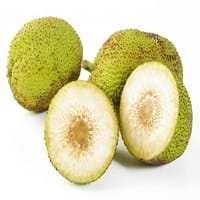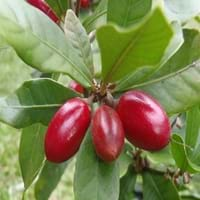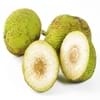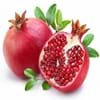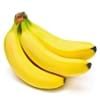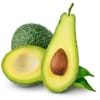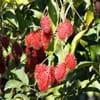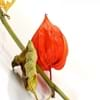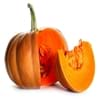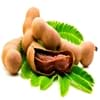Health Benefits
Cancer prevention, Heart care, Maintains healthy cholesterol level, Treatment of skin Diseases
Good for diabetics, Improves well-being, Miraculin/miracle fruit makes sour things taste sweet
General Benefits
Boosts immune system, Digestive aid, Helps in weight loss, Maintains healthy cholesterol level
Has taste modifying effect
Skin Benefits
Anti-aging benefits, Skin rejuvenation, Treatment of skin diseases
NA
Hair Benefits
Protects hair, Regulates hair growth, Treatment of dandruff
NA
Allergy Symptoms
Hives, Inflammation of nose, Swelling of mouth, tongue or lips
Itching, Skin rash
Side Effects
Allergic reaction
Changes taste of food eaten after this fruit, Coagulation
Best Time to Eat
Along with meal, As a snack in the late afternoon, Don't consume at night and before bed, Don't eat after meal
As a snack in the late afternoon, Eat the fresh ones, avoid mixing with any other foods, don't eat after meal., Morning time (before lunch)
Protein to Carb Ratio
Not Available
Vitamin A (Retinol)
Not Available
Vitamin B1 (Thiamin)
Not Available
Vitamin B2 (Riboflavin)
Not Available
Vitamin B3 (Niacin)
Not Available
Vitamin B5 (Pantothenic Acid)
Not Available
Vitamin B6 (Pyridoxin)
Not Available
Vitamin B9 (Folic acid)
Not Available
Vitamin C (Ascorbic Acid)
Vitamin K (Phyllochinone)
Not Available
Lutein+Zeaxanthin
Not Available
Water Content
Not Available
Calories in Fresh Fruit with Peel
Not Available
Not Available
Calories in Fresh Fruit without Peel
Not Available
Calories in Frozen Form
Not Available
Not Available
Calories in Dried Form
Not Available
Not Available
Calories in Canned Form
Not Available
Not Available
Calories in Juice
Not Available
Calories in Pie
Not Available
Type
Fruit vegetable, Tropical
Berry
Season
All seasons
Monsoon
Varieties
Koqo, Tamaikora, Temaipo, Uto Kuro, Samoa, Buco Ni Viti and Kulu Dina
Gymnema Sylvestre and Thaumatococcus Daniellii
Color
White, Yellow
Dark red
Inside Color
White
Greyish-white
Origin
South Pacific
West Africa
Soil Type
Loam, Sand, Sandy loam, Well-drained
Well-drained
Climatic Conditions
Humid, Rainfall, Warm
Rainfall
Facts about
- The milky sap of breadfruit tree is used as glue & bark is used to make papers.
- Breadfruit tree produces 1st fruit after 2-3 years from planting & remains productive for decades.
- The seeds of breadfruit are edible.
- The name 'Miracle' because of the magical experience you get after eating it.
- When you have lemon after eating this fruit, it tastes sweet as if it is added with sugar.
- It is also used as natural sweetener.
Other Countries
Africa, India, United States of America
NA
Top Importer
United States of America
Not Available
Top Exporter
Jamaica
United States of America
Botanical Name
Artocarpus altilis
Synsepalum Dulcificum
Synonym
Artocarpus communis or Artocarpus incisa
Miracle Berry, Miraculous Berry and Sweet Berry
Subkingdom
Tracheobionta
Tracheobionta
Division
Magnoliophyta
NA
Subclass
Magnollidae
Asteridae
Family
Moraceae
Sapotaceae
Genus
Artocarpus
Synsepalum
Species
A. altilis
S. dulcificum
Generic Group
Mulberry
Not Available
Difference Between Breadfruit and Miracle fruit
We might think that Breadfruit and Miracle fruit are similar with respect to nutritional value and health benefits. But the nutrient content of both fruits is different. Breadfruit and Miracle fruit Facts such as their taste, shape, color, and size are also distinct. The difference between Breadfruit and Miracle fruit is explained here.
The amount of calories in 100 gm of fresh Breadfruit and Miracle fruit with peel is Not Available and Not Available and the amount of calories without peel is 103.00 kcal and Not Available respectively. Thus, Breadfruit and Miracle fruit belong to and category.These fruits might or might not differ with respect to their scientific classification. The order of Breadfruit and Miracle fruit is Rosales and Ericales respectively. Breadfruit belongs to Moraceae family and Miracle fruit belongs to Sapotaceae family. Breadfruit belongs to Artocarpus genus of A. altilis species and Miracle fruit belongs to Synsepalum genus of S. dulcificum species. Beings plants, both fruits belong to Plantae Kingdom.
